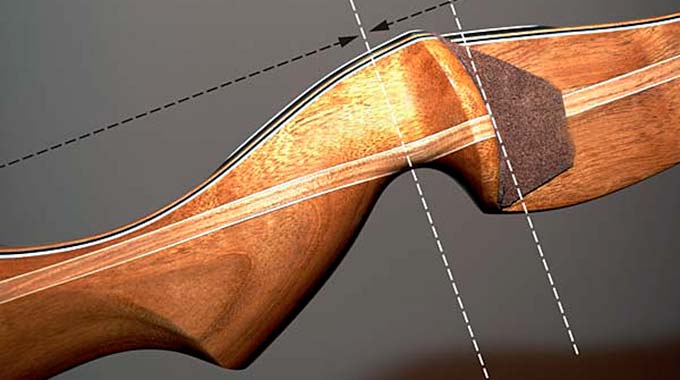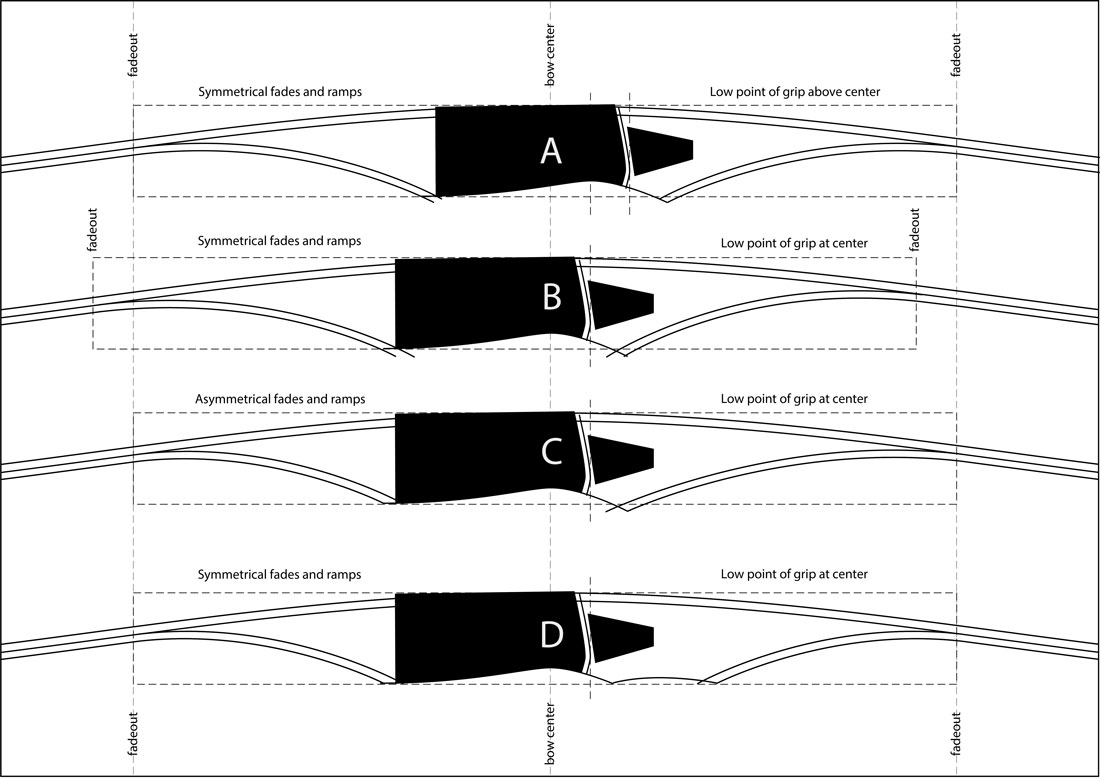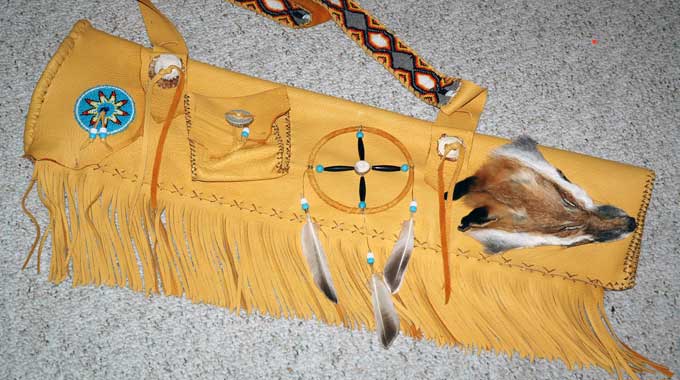I’ve experimented with making longbows with four different riser layouts. Riser A represents probably the…
Grip and shelf location
A question that appears often in many of the internet bow making forums is “Where should I locate the grip and shelf on my bow?” I’m sure there are as many opinions about this as there are bowyers, so I’ll give a simple explanation of what I think is important and you can decide what is best for you. I think the two most important things that should determine the location of the grip and shelf are bow balance and shooting style…meaning whether the archer intends to shoot “split finger” or “three fingers under.”
Putting the grip in the center of the bow (from tip-to-tip) creates a balanced bow that is easy to carry on the range and in the field. Holding an unbalanced bow for even just a few minutes can seem like agonizing long hours when you are trying to stalk quietly through the brush or stand perfectly still on a tree stand. A balanced bow is easy to carry and effortless to hold. Also, when it is time to raise the bow for the shot, a balanced bow comes up smoothly and effortlessly, without conscious thought or distraction.
There can be a difference between a balanced bow to carry at brace (let’s call this “static balance”), and a balanced bow during the draw (let’s call this “dynamic balance”). The dynamic balance of the bow is mostly determined by the bow grip fulcrum and the string grip location. This is where shooting style and tiller come into the discussion. For the ease of bow making, I’ve typically just cut the grip at the center and put the shelf an inch or so above it for both split finger or three under shooters, then adjusted the tiller to balance the bow. On my designs, the tiller usually comes out pretty close to what most authors suggest (“1/8″ positive” tiller—lower limb stronger and upper limb weaker for split fingered shooters, and “even” tiller—both limbs of equal strength for three finger under shooters).
However, after building bows for awhile and doing some experimenting with test bows on my tillering tree, I’ve learned to worry less about what everyone else is teaching about tiller and to be more concerned with how my bows balance on the pivoting tree. I’ve discovered that putting the grip at bow center usually works best for three under shooting and putting the grip slightly below center works best for split finger shooting. This places the bow grip and string grip locations so they create better dynamic balance in the bow. Once the grip is cut in, I use the tillering tree to show where the limbs need to be adjusted to create static and dynamic balance. In my opinion, it really doesn’t matter what tiller measurement the bow ends up with. After all, it’s just a measurement. What really matters is that the bow is balanced. Dynamic balance means that, during the draw stroke, the limb tips pull back the same distance at every inch on the tillering tree, and during the power stroke, they return back to brace with exactly the same force. You will know the limbs are perfectly balanced when they just make a dull thump when you strum the string. The dull thump happens because the force vectors of the upper and lower limbs perfectly cancel each other out as the limbs come to a stop. If the limbs are out of balance, the forces will not cancel each other, causing vibration and making the string buzz.
Please share with your friends and feel free to leave a comment.





Am I correct in assuming that this vibration could also come from vertical instability as well as unbalanced limbs. For example, I have this bow that I made for a friend that really needed more pad angle than I gave it, but on the tillering tree looked really good… it has a fair amount of vibration when you just pluck the string at brace, but shot great, a real point and shoot bow… The limbs did however have a decent amount of vertical instability compared to other designs I tinkered with.
Am I likely reading the tree wrong? or am I possibly correct and the instability problem cause the vibration?
Next set of limbs will have less taper and more pad angle to compensate, so I may answer my own question. But any help would be appreciated.
Hey David, good to see you over here!
I don’t think I can answer this question without doing some specific testing. I know one bowyer who believes very strongly that preload at brace affects vibration after the shot, but it would be hard to prove without testing some slack string bows. If you could get a slack string bow to shoot vibration free, then you would know. Just thinking out loud, I have to think that a perfectly balanced slack string bow “should” have low vibration. If the limbs are returning to brace at the same time, then they “should” cancel each other out when they come to stop. This is why I like to always consider “unbalanced moving mass” as the culprit when there is vibration. Moving mass is the amount of mass that is moving. It does not necessarily mean it is the mass of the entire limb.
Maybe that is why you can adjust the limb angle and change the amount of vibration? It must be because it affects the balance of the moving mass in the limbs?
I think the best method of reducing vibration when making a new bow is balancing the bow on the tree and reducing mass in the tips. Usually by sanding or shaving the sides of the mid-outer limbs and the outer six to eight inches of the tips will significantly reduce vibration. That being said, I have made bows with wide, heavy limbs that were vibration-free, but also made bows with scary, lightweight limbs that shocked like crazy.
It might be that (if the limbs are slightly out of balance/have unequal moving mass) the limbs tend to stop vibrating sooner when there is higher string tension at brace. Whereas, on a bow with very low string tension, the limbs will be less “tethered down” so to speak and more likely to flop around. I think Steve Gardner’s (Badger) theory about “the bulge” is related. You know, the concept that when the string tightens up and the tips come to a stop, the rest of the limb tries to keep moving forward due to it’s higher momentum. I think when the limbs “come to a stop,” this creates a shock wave that travels down each limb towards the handle. If the shock waves meet in the handle of the bow with equal force, then they will cancel each other out. If they meet somewhere other than the handle or with a different amount of force, then the stronger shock wave overrides the weaker one and continues to the tip of the bow on the weaker side, then it turns around and travels back to the other side.
If you watch slow-mo videos of bow limbs coming to a stop you can see these shock waves moving down each limb towards the handle.
This is just my theory.
Thanks for your comment!
Jim
I got ya, makes total sense the way you explained it. Could it also be that my tree, which is designed to mimic my grip on the bow, does not coincide with the center of mass? I made the tree to act like a hand with an angled piece of wood, with a leather overlay to “fill the grip” to simulate heeling the grip… I noticed yours is like a round dowel if I am seeing it correctly. I really heel the grip a lot when I shoot, I guess I learned that from compound shooting with low wrist grips and the recurve grips I make are more medium to high wrist.
David,
I think the way you are mimicking your grip on the tillering tree is the best way to balance the bow. You might try a different type of string, like a flemish string with high performance string material and see if that reduces vibration. I use the cheapo endless dacron strings from Bingham Projects for tillering my bows because they are so cheap, but they make my recurves vibrate like a tuning fork…lol. When I make a 8125 or a 450+ or a D97 flemish string, they quiet right down and don’t vibrate. I’ve determined that it is the bulky nylon serving on the loops that causes limb slap and vibration on my recurves. Of course, you can also play with increasing the brace height. Some recurves require 8″ to even 9″ to shoot quiet.
I have developed a strong opinion about tillering for different shooting styles. I’ve done testing with a “test” bow and with real bows and discovered that moving the grip lower (closer to the lower limb) helps balance a bow shot split finger. The testing revealed that it is the position of the hand on the grip and pulling point on the string that determine dynamic balance the most. Just try pulling one of your bows with different bow hand and string hand positions and see how it affects the balance. Try moving your hands closer together and farther apart. Try doing this on the tillering tree and see what happens to the balance of the bow. This will quickly show you that the pushing and pulling locations affect balance the most. The reason that a lower grip helps balance a bow for a split finger shooter is because there is a (bigger) distance between the bow grip position and the string grip position. When you move the grip down, it also moves the string pulling location closer to the center of the string. Do some experiments with the string pulling location and you’ll find that it makes a really big difference…maybe more than the bow grip position. Moving the grip down also makes the lower limb behave like it is shorter and effectively stronger. Ba-bing, now it doesn’t have to be thicker and wider and tillered as much different as the top limb. I have discovered that if you adjust the grip position to a certain optimum location for each length of bow that the tiller sometimes doesn’t have to be adjusted much at all. The bow also pulls back without rocking or pivoting at the bow hand fulcrum.
My current procedure is to glue up and cut out all bows–longbows and recurves–with equal length and equal strength limbs and a long riser. First, before the grip is cut, tiller them out as equal (pushing on riser center and pulling from string center) on the tree out to about 18″ or 20″, then move the pushing and pulling locations to match the intended shooting style and finish out the tillering from there until the limb tips pull down to the same position on the tree. When the bow pulls balanced, then cut out and shape the grip and retest the balance on the tree. This results in a balanced bow with the least necessary difference in limb strength (tiller). I’ve never read or heard of anyone else suggesting this method but it really works. The cool thing about this is that you don’t have to use anyone’s “one size fits all” tillering recommendation of 1/8″ positive or 1/8″ negative or whatever. The tiller measurements won’t matter if the bow is balanced. It also works for any and all shooting styles. For split finger shooters, you end up with limbs that are equal length and almost equal strength, but an asymmetrical riser.
Jim
Excuse the extra comment, but I had an extra thought or two…
1. that maybe I need to re-design my tillering tree and not worry about the grip style as much, and just concentrate on getting the bow balanced in general first.
2. Also, this would lead me to believe that the standard tiller that I usually do, which is 1/8″ positive as I shoot split 3, may not be ideal for shock reduction. It seems that anything off of zero, or balanced, tiller would cause vibration at brace when you describe the pluck method to test for it, but that may not necessarily transfer to shock on the shot depending on how the bow balances when any single individual with their unique grip draws and releases, if that makes any sense? Any advice you could give with regard to different tillers for different bow grips would be greatly appreciated.
You’ve definitely given me much more to think about on my next effort.
dave
Hi Jim!! Can you tell me where is the best spot to place the hook on the string when pulling a bow on tilleting tree for splitfinger, and which way to pull it ( strait down in line with center of the bow grip fulcrum, or slightly offset towards uper limb in line with the arrow)? Deepest piont of the grip is about 1/8″ below bow center, and shelf is about 3/4″ above center. I use similar tillering tree as you do.
Denis from Serbia
Hey Denis,
I agree 100% with what you are suggesting. To create the best bow balance we need to imitate the pushing and pulling locations of the real shooter. I think that the best place to place the hook on the string for pulling a bow for split finger shooting style is usually where the middle finger contacts the string. Here is a tip…tie a loop of string at this location and pull it from there…that keeps the pulling hook from sliding on the string. 🙂 The middle finger seems to be the center of pressure. LIke you suggest, I think it is best to put the bow grip fulcrum at the pivot on top of the tillering tree, and pull straight down in line with the arrow. This means moving the pulley at the bottom of your tillering tree to be in line with the arrow. Having your grip about 1/8″ below center will help create better balance for split finger shooting, but you could probably move it even closer to the lower limb and get even better balance. This will make the lower limb behave as if it is effectively shorter and stronger and you won’t have to weaken the upper limb as much. The next step is to tiller the limbs so the tips pull to the same distance at full draw and the limbs bend similar to each other and evenly throughout the working area. You have this figured out. This method will result in really nice shooting bows. 🙂
Jim